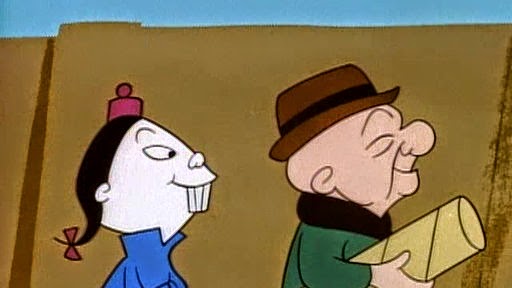What else can one say about that one-joke wonder, Mr. Magoo? As a kid I suffered through this poorly animated cartoon about an oblivious old myopic white guy and his manservant Charlie, depicted as a pigtailed, slanty-eyed, bucktoothed, Asian stereotype who's always shouting, "Mistah Magloo!" and calling the man "Bloss."
Hoo boy. A popular cartoon that's racist and ableist. I'd like to say that I can't believe I was allowed to watch it, or even that the TV station was allowed to air it. I'd also like to say that it's been discarded and forgotten as an antiquated artifact from the pre-PC era, but none of these statements would be true: Magoo lives on into another century, perpetuated in part by Disney's live-action remake. They even tried to PC-ify their version by transforming Charlie into a pan-global female love interest for Magoo's nephew, and then inserted this end-of-film disclaimer:
Hoo boy. A popular cartoon that's racist and ableist. I'd like to say that I can't believe I was allowed to watch it, or even that the TV station was allowed to air it. I'd also like to say that it's been discarded and forgotten as an antiquated artifact from the pre-PC era, but none of these statements would be true: Magoo lives on into another century, perpetuated in part by Disney's live-action remake. They even tried to PC-ify their version by transforming Charlie into a pan-global female love interest for Magoo's nephew, and then inserted this end-of-film disclaimer:
Siskel and Ebert sum all of it up in their review:
So Disney made a crappy film, based on a crappy cartoon. But Magoo serves an important role in popular culture. While other movies portray people with visual disabilities as having absolutely no vision, Magoo is one of the few mainstream media representations of someone with low vision. He's become an ableist cultural icon, an insult lobbed at people who act like they don't see something that's right in front of their faces. Magoo also gives context for understanding how people with disabilities can be misunderstood when they pass as abled—like a very nearsighted person who doesn't walk around with dark glasses and a white cane. To Magoo's credit, his antics are somewhat accurate. Too bad they couldn't have done that with a good film.


No comments:
Post a Comment